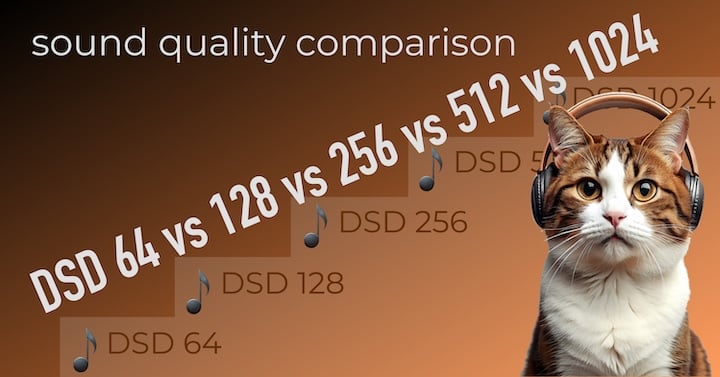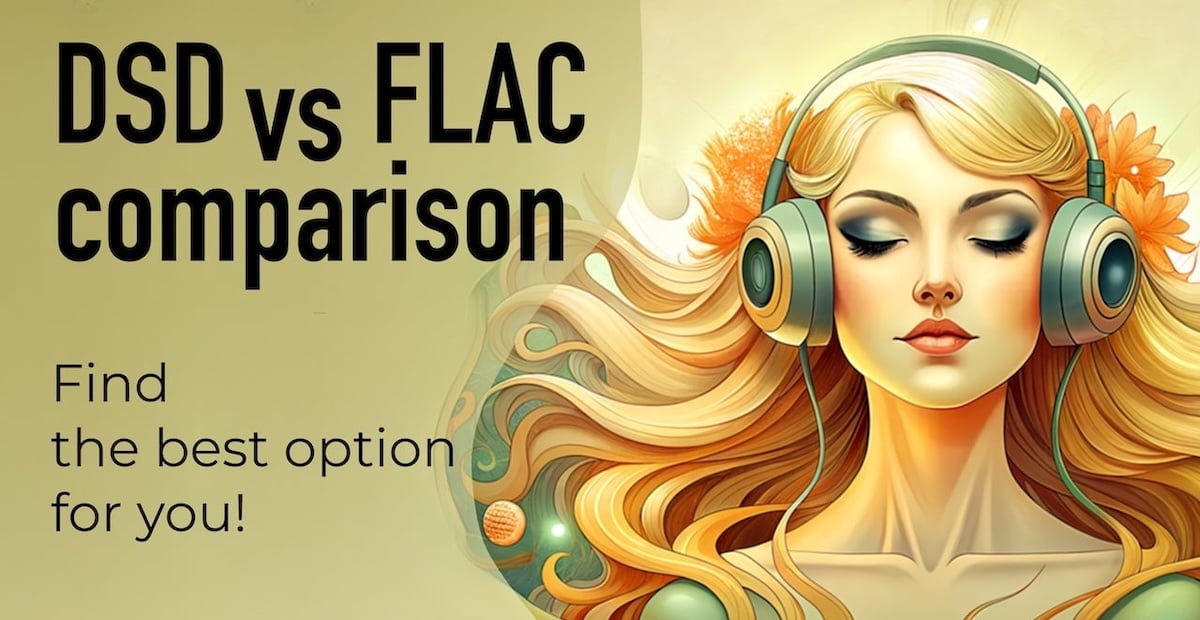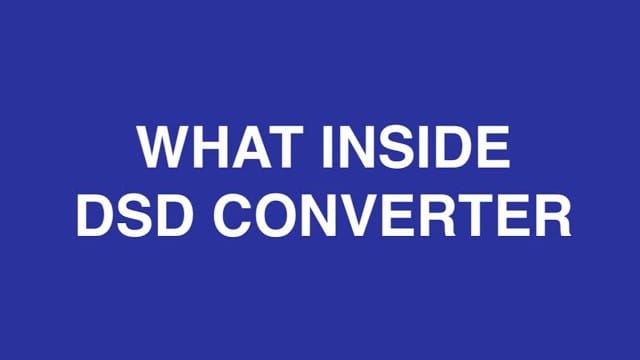
The DSD audio format is designed for music enthusiasts seeking superior sound. It captures audio at a simple 1-bit depth but at extremely high frequencies: DSD 64 at 2.8 MHz, DSD 128 (DSD 5.6 MHz), DSD 256 (DSD 11.2 MHz), DSD 512, and DSD 1024. Explore the article to understand how Direct Stream Digital's sound clarity at various rates, and compare DSD with common formats like WAV and FLAC, which use more bits but lower frequencies.

If you buy "AuI ConverteR PROduce-RD" (2023/12.x version) from 24 August 2023 to 24 October 2023, you will get free update to version 2024 (13.x) after its release.

Back to top
Understanding DSD
DSD, short for Direct Stream Digital, is a type of high-quality audio format. You can find this audio in files ending with .DFF, .DSF, or .ISO. The .ISO files are also known as SACD ISO, which are digital copies of Super Audio CDs.
DSD is designed to carry sound inside the lowest part of the frequency band. The remaining audio spectrum carries a type of sound called modulation noise.

Look at video about DSD converter.
DSD explained simply:
Think of DSD audio format as a bowl.
The center of the bowl holds the soup (the music we hear).
The edge of the bowl (DSD noise) has no soup. We hold the edge to carry the bowl (DSD) with the soup (music).
A 1-bit signal has a lot of noise compared to the audio signal it sends. A process called noise shaping moves the noise energy to high tones. This way, the low tones have less noise.
Think of DSD noise as water in a pool.
At the bottom of the pool, under water, there is a box (music).
A huge fan (noise shaping) starts blowing the water (noise) where the box (music) is.
The water level under the fan goes down. And the top of the box (music) comes out of the water (the music becomes clear in the noise background).
Pushing the noise too hard to high tones can make the sigma-delta modulator less stable.
Watch video how DSD converter works >
Using more bits reduces the noise level in the audio band. So, less force is needed to push the noise to high tones. This means less space is needed for the noise band at high tones. And, the sample rate (the total DSD band) can be lower.
Read more details >
Back to top
DSD sample rates
DSD stands for a digital sound process known as sigma-delta modulation. The sample rate (sampling frequency) is an important feature of the DSD modulation.
The frequency levels of DSD are multiples of 44,100 Hz, the same frequency used for CD audio:
- DSD 64: Captures sound at 2.8 MHz (2,822,400 Hz), which is 64 times the CD audio rate;
- DSD 128: Records at 5.6 MHz (5,644,800 Hz), or 128 times the CD frequency;
- DSD 256: Achieves 11.2 MHz (11,289,600 Hz), 256 times higher than CD quality;
- DSD 512: Reaches 22.6 MHz (22,579,200 Hz), 512 times the base rate;
- DSD 1024: Hits 45.2 MHz (45,158,400 Hz), 1024 times the standard CD audio frequency;
- and so on.
Check DSD music site download list (also FREE downloads there) >
Look at free DSD players (Windows, Mac, Android, iOS) >
Read about sample rate and sound quality >
As rule, DSD has 1-bit resolution. Multibit DSD may be used (read below).
Back to top
DSD audio converters
- ISO to DSF, DFF (DSD files) >
- ISO to FLAC WAV mp3 (PCM files) >
- DSF to FLAC >
- DFF file converter >
- DFF to DSF >
- Convert DSF to mp3 >

Back to top
How DSD sounds
DSD is a type of high-quality audio format that uses 44,100 Hz as the base frequency in most cases. It uses a device called a sigma-delta modulator to create 1-bit audio from more complex audio. The performance of the device varies depending on how it is made.
Sound quality is how much noise interferes with the sound we hear.
Comparing different DSD levels
| DSD level | Noise level, dB | Similar to PCM |
|---|---|---|
| DSD 64 | around -125 ... -145 dB | close to PCM 24 bit (-144 dB) |
| DSD 128 | around -160 ... -165 dB | between PCM 24 bit and PCM 32 bit |
| DSD 256 | around -170 ... -200 dB | like PCM 32 bit |
| DSD 1024 | around -170 ... -200 dB in 100 kHz range | like PCM 32 bit |
The device has a limit on how much input music it can handle. If the input is too loud, the device can lose its balance and produce silence or unwanted sounds. Some DSD files have a 6 dB buffer (headroom, extra space for the highest sound level) to avoid this. Learn more here >
A higher DSD rate means more technical options to reduce noise in the sound we hear while keeping the device stable.
Back to topComparing DSD and PCM. How does DSD differ from FLAC?
DSD and PCM are both types of digital sound.
DSD uses the simplest form of sound (1-bit). This makes a lot of noise in the sound.
DSD uses a larger range of sound, which reduces noise in the range we can hear (0 ... 20 kHz). But this is not enough.
Learn how DSD solves the noise problem here >
FLAC is a kind of PCM sound. So, it applies to FLAC too. Learn more here...
Back to top
Frequently Asked Questions
What is DSD64?
DSD64 is an audiophile format with [44.1 kHz x 64] sampling rate and 1-bit resolution.
CD-audio sampling rate (44.1 kHz) is assigned as basic value.
See more...
What is DSD128?
DSD128 is a HD sound format with [44.1 kHz x 128] sampling rate and 1-bit resolution. See more...
What is DSD256?
DSD256 is a high-resolution format with [44.1 kHz x 256] sampling rate and 1-bit resolution. See more...
What is DSD512?
DSD512 is a hifi audio format with [44.1 kHz x 512] sampling rate and 1-bit resolution. See more...
What is DSD1024?
DSD1024 is a hi-res audio format with [44.1 kHz x 1024] sampling rate and 1-bit resolution. See more...
Is DSD64 a SACD?
DSD64 is sampling rate of SACD optical disk.
Is DSD the best audio format?
DSD is one of the best audio formats by sound quality. Lossless PCM format family is an alternative to DSD.
Actual sound quality depends on recording, playback equipment and software.
What is PCM vs DSD?
Read about comparison PCM and DSD here...
Is DSD better than FLAC?
In general case, both DSD and FLAC have its own benefits.
Read about DSD vs FLAC comparison here...
Is MQA better than DSD?
MQA is PCM. Both PCM and DSD have advantages and disadvantages. It's defined by recording and implementation of audio system.
Also, MQA is not lossless in FLAC meaning.
However, MQA significantly saves computer storage space and reduces throughput via a network for high sound quality.
Read more...
Is DSD audio worth it?
There is no single answer. Theoretically, DSD is the best audio format by sound quality due to wide band and simpler ADC and DAC.
Note: For audio engineering wide band and ultrasound playback is not the same.
However, DSD causes issues with editing. And actual equipment implementation is not the same theoretical concept.
So, you should decide based on available equipment and recordings in given personal conditions.
What is DXD audio format?
DXD is PCM audio format, produced from DSD for audio processing, editing. Read more...
Is DSD better than PCM?
We wan to know Which is better DSD or PCM? each of them is converted to analog audio in different ways. It causes different distortions. Distortion level depends on audio equipment and software implementation.
Is DSD better than FLAC?
To answer the question does DSD sound better than FLAC, we should note that FLAC is PCM. So, PCM and DSD should be compared. Read details...
What is DXD audio format?
DXD (Digital eXtreme Definition) format is PCM format, that contains DSD audio spectrum including noise.
DXD is intended for DSD audio editing.
DXD has high sampling rate 352.8 kHz and bit depth 24/32-bit. So, DXD provides wide frequency band of audio signal.
It allows cause lesser distortion of DSD to PCM conversion due to lesser ringing for wider total signal band.
Quality of the conversion is depending on converter software tool.
Is DXD better than DSD?
DXD and DSD format are the same mathematically. However, both ones are converted to analog signal in different ways and sound may be different.
Is DSD128 good?
DSD128 has a higher sampling rate than DSD64. Theoretically, it allows pushing of more energy of DSD noise in the higher part of the spectrum.
So, we can apply ether wider useful audio band or get lesser noise.
Real result is defined by recording and implementation of playback setup and software.
Read more...
Where can I get a DSD?
You can download free DSD samples here...
Also, see list sites with DSD music...
Back to top
DSD samples
- DSD vs DSF vs DFF Files Audio. What is difference >
- Check FREE DSD downloads >
- DSD and PCM. What is common base? >
- What is DSD audio [How it work, Play, Convert, Edit and more] >
- DSD Converter of Audio Files: What Inside? >
- DSD Decoder Audio >
- How to work sigma-delta modulation in audio >
- What the best audio file format
Audio Basis - articles about audio
Back to top